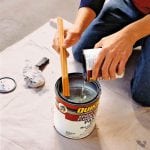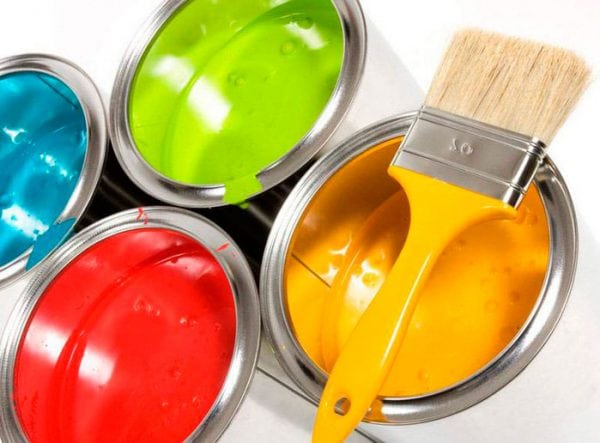They say that repairs cannot be completed, but can be suspended for a while. It is unlikely that any of us will disagree with such a statement, because we are all more or less familiar with the repair firsthand. If you are not a professional, then you may encounter many features of finishing classes already in the process of updating. For example, many were perplexed by the following question: how can one dilute a thickened water-based paint?
- Features of water-based paints
- Types of water-based paints
- Before starting work
- Instructions for use


Features of water-based paints
Before answering our main question, it should be well understood what a water emulsion is.
Aqueous emulsion ink is an environmentally friendly paint and varnish material, the connecting element of which is water. Thanks to the distinctive composition, this type of paint is well suited for interior and exterior decoration of buildings and houses.
The clear advantages of emulsion paint are:
- the ability to paint any wall surface (with putty or with wallpaper, drywall, wood or concrete);
- environmental friendliness (does not harm health even with time);
- ease of use;
- durability (does not exfoliate and does not crumble).
You must admit that the positive points listed above are valuable arguments in favor of acquiring water-based paint.
to contents ↑Types of water-based paints
If in search of a suitable paint you find yourself in any specialized store, then you are simply confused by the large number of assortments. Therefore, even before going to the store, it would be nice for you to even understand a little bit about the numerous types of water-based paint.

Depending on the substances from which the material is made, a water emulsion can be:
- Latex (very popular because of its functionality: painted walls can be washed; it protects against minor external damage and even glosses over cracks).
- Acrylic (made from acrylic resin and pigment; provides walls with additional moisture resistance, strength and elasticity; the most expensive of all).
- Silicone (made by mixing water and silicone resin).
- Silicate (consists of pigment, water glass and alkalis; does not have the property of repelling moisture; it is advisable to wear a special suit during decoration).
- Polyvinyl acetate (made with PVA glue; the cheapest, but the least durable compared to others).
Now, armed with basic knowledge about varieties of water-based paint, you can safely go and buy the necessary goods.
to contents ↑Before starting work
So, the painting material is purchased and is at your home. They decided that the most difficult thing - to make a choice - is already behind? In fact, all the basic work is just beginning.
Let's say you need to paint the ceiling or update its color. A water based paint base is the best suited for these purposes. The ceiling does not require pretreatment with any solution or the use of other coloring raw materials. As we noted earlier, it itself perfectly lays down and does not crumble.
Before you start, make sure that you have everything you need at your fingertips, namely:
- clean water at room temperature;
- a clean bucket;
- color if necessary;
- construction mixer;
- disposable rubber gloves;
- roller or brush.
Instructions for use
Opening the jar, you will immediately realize that due to prolonged downtime, the emulsion thickened and it is advisable to dilute it with something before use. What is the best way to dilute water-based paint? The answer is very simple and lies in the composition. Water, which is one of its main elements, is perfectly suited as a diluent.
An important point: painting works are carried out at a temperature of at least 5 ° C.
Pour a small amount of paint into a clean plastic bucket, then add a small amount of water there and mix with a construction mixer. It is very important that water is only 1/10 of the total mass. Try to adhere to this indicator all the time while diluting the paint.
During the stirring procedure, a little foam may form. It is worth starting the painting after it has completely settled. To check whether you have achieved the desired consistency, use a brush or roller to apply one coat of paint to the ceiling or wall. If it lays down in an even, beautiful layer, without leaving a trace of the bristles of the brush, then the water emulsion is diluted correctly and you can start painting.

If your paint is white, but there is a tint solution, you can make an independent tint. To avoid the mistake of non-professional finishers, consider the helpful tip. No need to add color right away in a bucket of paint, otherwise you risk overdoing it. The best option would be this: mix a few drops of the tint solution with paint in a separate shallow container. Bring to the desired color scheme. Now you can, gradually stirring, pour the resulting mass into a common boiler.
Water Emulsion Staining Technique no different from finishing work with any other paint. On the surface with an eye on the drying time of each layer, a new one is applied (optimally 2-3).
As with any finishing work, some material may remain at the end of the painting. In our case, this is an emulsion. Pour it into a clean plastic bottle with a tight-fitting lid and leave it in a dark place (where the temperature does not drop below 5 ° C) until the next time.
Anyone who has ever used a water-based paint, almost always with a 100% guarantee, will choose it for the next repair. The ease of use and the undoubted advantages of these paints over others make them especially attractive in the eyes of people who value high quality and practical durability.



